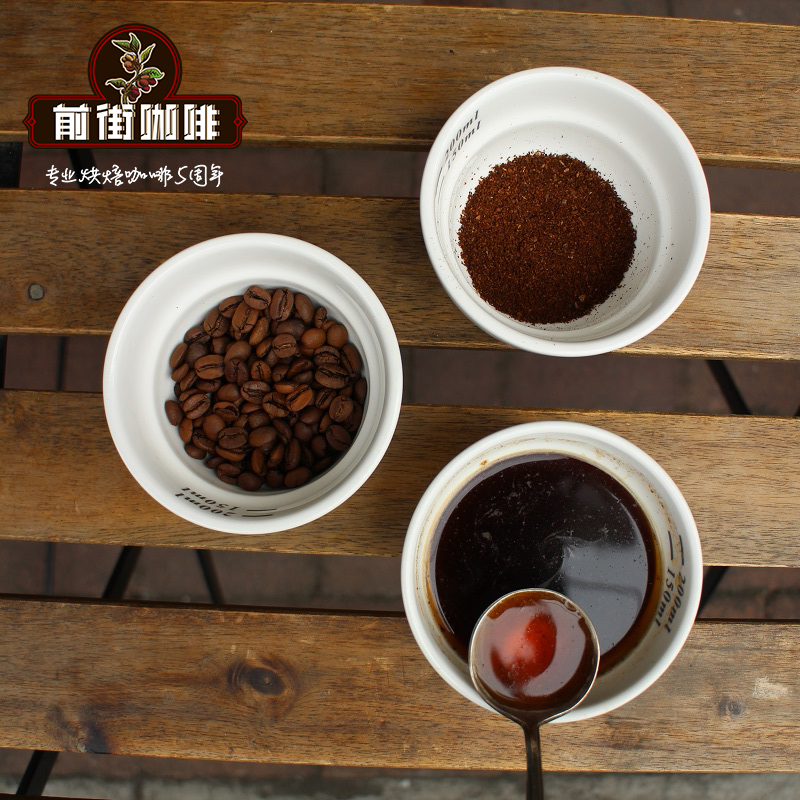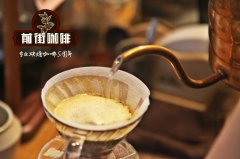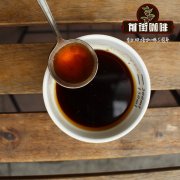Guatemala Antigua small flower god coffee hand brewing parameters suggested _ Antigua small flower god coffee beans are delicious

Professional coffee knowledge exchange More coffee bean information Please pay attention to coffee workshop (Weixin Official Accounts cafe_style)
Guatemala Antigua
Antigua, Guatemala
(Guatemala La Minita La Folie)
Production area: Antigua volcanic area
Manor: La Minita
Export: La Minita Group's brand "Flower God"
Breed: Caturra, Catuai, Borbon
Bourbon, Kadulla, Kaduai
Altitude: 1200 to 1600 m
Grade: European washed hard beans (SHB)
Treatment method: Traditional washing treatment
Harvest: N/A
Certification: N/A
Flavor Features: Flower God has a very pleasant and elegant floral body flavor,
Soft acidity and chocolate-like finish, overall clean and bright taste.
Sweet and smooth, fruit acid layers, fruit and floral taste.
01. Brief introduction of production area
Guatemala is located in the Central American Isthmus, where many volcanoes form mountains and plateaus, producing high-quality Central American high-altitude very hard coffee beans, ranking as the ninth largest producer of coffee beans in the world. Guatemala coffee producing areas are Antigua, Huehuetenango, Atitlan, Coban, Fraijanes, Acatenango and other seven major producing areas. Guatemala, which has seven major coffee producing areas, produces Arabica coffee beans, which are located in the highland terrain under subtropical climate. The rainfall is abundant and stable, and the fertile volcanic ash soil makes all parts of Guatemala have natural environmental conditions very suitable for coffee cultivation.
The valley is surrounded by three volcanoes: Agua, Fuego and Acatenango. Ash from the eruption enriched the soils of Antigua with minerals. Volcanic pumice keeps humidity and overcomes the lack of rainfall in Antigua; dense shade protects against occasional frosts.
[Features] Rich wet fragrance, good balance, high sweetness, delicate body.
Each region has a unique flavor, superior acidity and fruity smooth mouth, belongs to one of the world's top coffee, suitable for single drink. Antigua is located throughout the topographically mountainous region of Guatemala, dominated by the Madre Plateau, because of its natural conditions, Antigua is the most famous producing area in Guatemala.
Antigua Coffee Region Introduction
Flower God is a brand bean owned by La minita. It is located in Antigua, Guatemala. It is a highland surrounded by active volcanoes. It is 1850 meters above sea level. It is the most award-winning and famous producing area in the country.
Antigua has little rainfall in summer, and occasionally frosts in winter because it is too cold. In fact, it is not suitable for the growth of coffee trees. Fortunately, Antigua is located in an active volcanic zone. After the volcanic light stones ejected from the volcano fall into the soil and cool down, these light stones have many fine pores and are very easy to retain moisture. In addition, a large number of shade trees are planted in the estate, so that coffee trees will not suffer from cold damage in winter. These factors overcome adverse conditions. In addition, there is a great temperature difference between day and night. Antigua creates a unique micro-climate, so that the coffee beans here have a light smoky flavor and strong fruit.
Laminita is famous for its excellent planting, processing technology and extremely strict quality control. They entrust Las Pastores, Antigua's largest local washing plant, to process raw beans according to such standards, and named the coffee beans Flower God. In addition to maintaining the original flavor of the producing area, the dry aroma has a strong floral and tea fragrance. After the entrance, the sour aroma of lime and berry fruit will turn into the ending rhyme of honey. Excellent cleanliness and rich layering are the characteristics of this Flower God.
Coffee growing at La Minita Estate
Laminita Manor does not use pesticides, and due to the geographical advantages of the manor formed by the climate and altitude, location conditions limit the number of pests, a few pests will not cause too much impact on coffee trees. At the end of the rainy season, the coffee fruit will ripen immediately, and the green fruit will start to turn red, but the coffee fruit ripens very slowly and unevenly, unlike the flowering, so the harvesting work must be handled more carefully, only the fully ripe deep red fruit is harvested.
The fruit of a tree can be harvested up to five times depending on its maturity. The estate conducts soil tests twice a year to determine how to fertilize, and La Minita is careful to use products that increase yield, fertilizing about three times a year.
In addition, trace elements such as zinc, boron and copper can provide more nutrients to coffee trees and prevent diseases. Such scientific cultivation management has created the excellent performance of the coffee flavor and the reputation of the same quality for several years. La Minita's famous control procedures are followed, strictly supervising the entire process of coffee from planting to packaging. These complicated procedures are to ensure that the Pastores processing plant provides the best quality and strictly control the standard operating procedures of the estate.
Antigua producing area itself is the most famous producing area among the seven major producing areas of Guatemala, with high altitude, unique volcanic soil and shade cultivation, so Antigua coffee beans have a unique flavor of special producing areas.
02. Treatment method
full washed
1. Remove floating beans Pour coffee beans into a large tank, incomplete inferior beans will float to the water surface, ripe and full fruits will sink to the bottom, at this time, remove floating beans on the water surface, that is, complete the step of removing floating beans.
2. Remove pericarp and pulp. Remove pericarp and pulp of coffee fruit through pulp sifting machine. (Pectin, endocarp and silver peel will remain).
3. The fermentation step is intended to remove pectin by biological treatment. The coffee fruit treated by the pulp screening machine is put into the fermentation tank for 16- 36 hours, and the fermentation bacteria will dissolve the pectin.
4. After the fermentation and pectin removal, the coffee beans will be washed again because the fermentation bacteria and impurities will remain on the coffee beans. To clean, this step consumes a lot of water.
5. Drying and removing endocarp and silver peel Dry coffee fruit to reduce moisture content to 10- 14%. Then, the remaining endocarp and silver skin are removed by using a hulling machine to complete the processing.
03. Raw bean analysis
[Guatemala Flower God Washing Method]
The varieties of Guatemala flower god are mainly bourbon, cadura and caduai. Bourbon and iron pica are juxtaposed as ancient coffee varieties with excellent quality. The bean appearance is smaller and more round than iron pica.
Kadura tastes sour with lemon or citrus, and is not as sweet as iron and bourbon, because the sweetness of kadura depends on the number and dosage of fertilizer applied by the grower. It has high productivity, but it must be continuously fertilized and pruned to maintain productivity, so the tree is short and branched. Although production capacity has increased, production is still limited due to the high cost of care due to the harvest period of 2 years.
04. Baking analysis
This Antigua coffee green beans round, green with yellow, good uniformity, moderate moisture content. The baking goal is medium baking, retaining the bright acidity on the one hand to show floral and fruity aromas on the other hand to enhance richness and balance.
In the first batch of baking, the lower bean temperature is relatively high, the temperature of the beans is 200 degrees, and the fire is relatively large. In the baking process, it was found that the altitude of this bean was higher and the bean quality was harder. In order to retain more acid aroma, the baking method of raising temperature and early explosion was adopted. The fire power was adjusted carefully before the beans entered the yellowing point, dehydration was completed and the first explosion was completed, so as to avoid the surface burn of the beans, and 1 minute and 50 seconds after the first explosion was selected to shorten the caramelization reaction time and retain more fragrance of flowers and fruits.
Baking machine Yangjia 600g semi-straight fire
The oven temperature was raised to 200 ° C and the oven was put into the oven. After the damper was opened for 3, 30s, the fire power was adjusted to 160 ° C. The damper remained unchanged. The temperature returned to 1 "36". The fire power was maintained. When the temperature was 4 '50 ", the bean table turned yellow. The smell of grass disappeared completely. The dehydration stage was entered. The fire power was reduced to 140 ° C. The damper was adjusted to 4.
4 '50"dehydration is completed, the fire is reduced to 140 degrees, 8 32" when the bean surface appears ugly beard wrinkles and black stripes, toast flavor obviously changed to coffee fragrance, can be defined as the prelude to a burst, this time to hear the sound of a burst point, to 8' 37 "to start a burst, reduce the fire to 80 degrees, fully open the damper 5 (adjust the fire to be very careful, not small to no burst sound), a burst after the development of 1 '50", 195.3 degrees under the pan.
This Antigua coffee flower god washed citrus acid is more obvious, the juice sour feeling, rich floral fragrance, pleasant sweetness, medium alcohol, the latter part has a slight caramel feeling and smoky taste, overall pure, mild, smooth texture, balanced and lively taste.
Antigua Coffee Brewing Analysis
Recommended brewing method: hand brewing
Abrasion: (Japan Kofuji R440) 3.5
V60 filter cup, 15 grams of powder, water temperature 91 degrees
Water powder ratio 1:15
Break: small water flow water injection to 125g cut off water, slow water injection to 225g
Total duration: approximately 1 minute 50 seconds
BG Grind 4R
Sweetness: † † †
Acidity: ☆☆
Bitterness: ☆
Other suggestions for trickle-filtration extraction: normal pressure, recommended grinding degree of 3.5-4, water temperature 91°C
Aile pressure, recommended 2.5 grind, water temperature 90°C
END
Important Notice :
前街咖啡 FrontStreet Coffee has moved to new addredd:
FrontStreet Coffee Address: 315,Donghua East Road,GuangZhou
Tel:020 38364473
- Prev

Sidamo producing area of Ethiopia | Bansa Cooperative Red Cherry Plan to mix local native species in the sun
Professional coffee knowledge exchange more coffee bean information please follow the coffee workshop (Wechat official account cafe_style) Ethiopia Sidamo producing area | Bansha Cooperative Red Cherry Plan Sun mixed local native species flavor? The coffee flavor of Sidamo is very diverse, and different kinds of soil, microclimate and countless native coffee species have created the coffee produced in every town.
- Next

Antigua Alem Volcano Coffee beans hand-made recommendation _ Antigua Fine Coffee beans recommendation
Professional coffee knowledge exchange more coffee bean information please follow the coffee workshop (Wechat official account cafe_style) Guatemala Antigua boutique coffee bean promotion 1, volcano Aram coffee beans produced in Guatemala one of the eight famous producing areas of Antigua, the canyon of this area is surrounded by three volcanoes: Agua, Tierra del Fuego and Arcatel Nanguo.
Related
- Detailed explanation of Jadeite planting Land in Panamanian Jadeite Manor introduction to the grading system of Jadeite competitive bidding, Red bid, Green bid and Rose Summer
- Story of Coffee planting in Brenka region of Costa Rica Stonehenge Manor anaerobic heavy honey treatment of flavor mouth
- What's on the barrel of Blue Mountain Coffee beans?
- Can American coffee also pull flowers? How to use hot American style to pull out a good-looking pattern?
- Can you make a cold extract with coffee beans? What is the right proportion for cold-extracted coffee formula?
- Indonesian PWN Gold Mandrine Coffee Origin Features Flavor How to Chong? Mandolin coffee is American.
- A brief introduction to the flavor characteristics of Brazilian yellow bourbon coffee beans
- What is the effect of different water quality on the flavor of cold-extracted coffee? What kind of water is best for brewing coffee?
- Why do you think of Rose Summer whenever you mention Panamanian coffee?
- Introduction to the characteristics of authentic blue mountain coffee bean producing areas? What is the CIB Coffee Authority in Jamaica?

